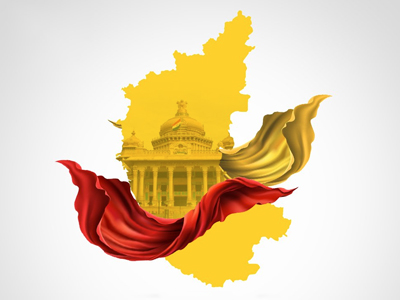Overview
On the 1st of November every year, Karnataka celebrates Kannada Rajyotsava, also known as Karnataka State Day. This public holiday commemorates the unification of Kannada-speaking regions in southwestern India in 1956, as per the States Reorganisation Act, leading to the formation of the state of Karnataka. Kannada Rajyotsava is a government holiday in Karnataka and is exuberantly celebrated by Kannadigas worldwide.

History of Karnataka’s formation
Post-India’s independence, Maharaja Jayachamarajendra Wodeyar willingly facilitated the integration of the Mysore kingdom into India. By 1950, Mysore emerged as an Indian state with the same name, and the former Maharaja assumed the role of Rajpramukh (governor) until 1975.
On the 1st of November, 1956, the Mysore state underwent a transformative union, encompassing most of the former princely state of Mysore. This integration extended to include the Kannada-speaking regions of the Bombay and Madras presidencies, as well as the principality of Hyderabad, resulting in the formation of a unified Kannada-speaking state.

The newly formed Mysore state incorporated three distinct regions: North Karnataka, Malnad, and Old Mysore. Initially, the unified state retained the name Mysore, the former princely state. However, the citizens of North Karnataka voiced a reluctance to maintain the name due to its close association with the old principality and the southern areas of the state.
Considering this emotion, a climacteric decision was made on the 1st of November, 1973, under the leadership of then Chief Minister Devaraj Arasu. The state’s name was officially changed to Karnataka, celebrating a significant milestone in its identity and reflecting a more inclusive representation of its diverse regions.
Etymology of Karnataka
Karnataka has numerous etymological origins, reflecting its rich historical and linguistic context. One acknowledged derivation stems from the Kannada words karu and nadu, meaning ‘elevated land’. Another etymological interpretation links the name to ‘black‘, inferring to the black cotton soil predominant in the region.
References to ‘Karnataka‘ can be traced back to ancient Hindu texts, including the ‘Sabha Parva‘ and the ‘Bhishma Parva‘ of the Mahabharata. Notably, in the Bhagavata Purana, Lord Rishabhadeva’s form is said to have concluded his avatar in the Kutakachala hill in the Karnata province.
![]()
Historically, scholars like Panini, Mrichchakatika, and Kathasaritsagara, as well as astrologer Varaha Mihira in the 5th century CE, made references to Karnataka in their works. Rashtrakuta inscriptions in the 7th century CE mention the armies of Chalukyas of Badami as Karnatakabala.
At the same time, the Tamil classic Silappatikaram refers to the region’s people as Karunatakars. The 9th-century Kannada classic Kavirajamarga hails the entire area between the rivers Kaveri and Godavari as Karnata, and later references in the 13th century and 16th century consistently use the term Karnataka.
Kannada Rajyotsava: A Day of Vibrant Celebration of Culture and Identity
Rajyotsava day illuminates Karnataka with vibrancy, as the entire state adorns a festive aura. The iconic red and yellow Kannada flags flutter proudly at strategic locations, symbolising unity and pride—the yellow and red flags representing arisana and kumkuma of Goddess Bhuvaneshwari, meaning turmeric and vermillion, respectively.

The resonance of the Kannada anthem, Jaya Bharatha Jananiya Tanujate, penned by the revered poet Kuvempu, reverberates. This anthem, officially declared the state anthem in 2004, encapsulates the spirit of Karnataka—a harmonious coexistence with sister states while upholding her self-respect and dignity.
Rajyotsava unfolds in Karnataka with a grand government procession, a testament to the state’s recognition of exemplary contributions. The prestigious Rajyotsava Prashasti/Awards are conferred upon individuals pivotal to the development of Karnataka. Prominent awardees for the 2023 Rajyotsava Prashasti include S. Somanath (ISRO Chairman), V. Gopala Gowda (Retired Supreme Court Judge), Charmadi Hasanabba (Social Service), and Lieutenant General Codanda Poovaiah Cariappa (Indian Army).
The Chief Minister inaugurates a vibrant cultural show at Kanteerava Stadium in Bangalore, setting the stage for the celebrations. Recognising excellence, awards are bestowed upon students who have excelled in various national games.
A celebration highlight is the captivating multicoloured tableau procession featuring the revered Goddess Bhuvaneshwari on an adorned vehicle. This vibrant spectacle is accompanied by the rhythmic beats of traditional instruments, showcasing the rich cultural tapestry of Karnataka.
Folk artists take centre stage, captivating the audience with enthralling performances in drama (Bayalata), traditional dance forms (Dollu Kunitha, Kamsale and Kolata), and classical Carnatic music.

In essence, Kannada Rajyotsava transcends the realms of festivity; it is a profound expression of identity, weaving together the tapestry of history, culture, and unity that defines the essence of this vibrant state. Beyond the festivities, it is a testament to Karnataka’s unique and enduring identity.











